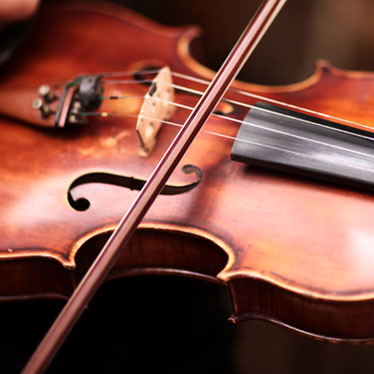
Is your bowing arm tired, shaky, sore, tensed, not doing what it's supposed to? It could be that your bowing arm needs a break. Overuse injuries are nothing to scoff at. At best, they are uncomfortable and make practicing or playing regularly impossible. At worst, they lead to invasive surgical treatments or permanent damage.
The following suggestions come from experienced string musicians and instructors, and emphasize how important it is to give your bowing arm a break once in a while.
Adjust the size, fit and position of your instrument
Are your instrument and bow sized correctly? If you're a beginner or intermediate student, and you haven't upgraded your instrument in a while, you may have outgrown it, and the poor posture and positioning required to play it is causing undue strain on your body.
Hopefully, your instructor is paying attention. If, however, you suspect size or fit is the problem, take your instrument to a reputable music store in the area and check in with the staff there. Their objective view may lead to helpful tips regarding posture and positioning that also contribute to the problem.
Ensure your bowing technique is sound
Good playing technique incorporates a range of things, including instrument/musician size and proportions, physical posture while seated and standing, as well as how your arm moves the bow. Any deficiency in these areas will result in tension or soreness.
If you're working with an instructor, they should be monitoring this for you and making suggestions you can work with during your home practice, in front of a mirror. If you are an advanced strings player and no longer work one-on-one with an instructor much, arm tension indicates it's time to consult with someone to look objectively while you play, amending any bad habits you've slipped into.
Read, 4 Tips for Better Violin Bowing, and search credible online sources for more tips on healthy bowing techniques for the violin or other string instruments.
Take deep breaths and relax
Any tension in your neck, arms and shoulders will show up in a tense or shaky arm. In addition to being sore, stress affects the quality of your tone and overall sound. Practice deep breathing or other relaxation techniques, incorporating them into your practice sessions, so they become second nature. The very act of embodying more holistic relaxation has a positive effect on your bowing arm. Check out 5 Breathing Exercises for Violinists, which is translatable for all string players.
Stop using it
Beginners should do their best to abide by healthy bowing techniques as much as possible to develop good habits as well as your musical ear. As you become more advanced, there may be times where note accuracy and fingering – rather than sound – is the priority. If this is the case, remember that the mind is a very powerful tool. Instead of bowing the notes, hold your instrument and finger the – sans bow – with the correct rhythm and timing and visualize yourself bowing beautifully.
After you've learned the difficult phrase, or system better on your fingering hand, apply the bow and continue from there. This can give it a much-needed break.
Give it a good workout
Did you know the physical demands placed on a string musician is similar to those of an athlete? If your bow arm is weak or under-exercised, it will show up in your playing and lack of stamina. Another bonus: the healthier and more in-shape your body is, the less prone it is to injuries in general. Read How to Strengthen Your Bow Arm, for exercises and activities particular to the arm. Then, check out one of the following articles, based on your instrument, to learn more ways to get your body in shape for practice and performances.
Since most musicians are also students and/or full-time workers, the exercises you do to strengthen your bowing arm, bod, and stamina also pay off in terms of stress relief!
Avoid tension in the first place
Why does your bowing arm need a break at all? Avoiding tension may solve your problem altogether. In this Strad article, Julliard professor Bonnie Hampton discusses how to avoid tension in the bow arm, and her points are relevant across the bowed instrument genre:
- Let gravity and the strings do the work. A little pressure from your bow hand is necessary, but too much pressure is counterproductive. Let gravity and the strings do the work for you in supporting the bow.
- Find the right balance. After applying the bow to the string, the right balance eases the bowing motion. Hampton writes, "If you hold the bow at the balance point of the stick you will get the clearest, most resonant sound."
- Think of a rubber band.


